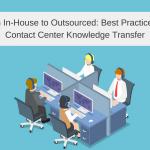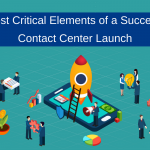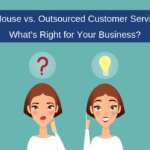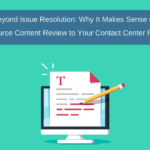Switching Vendors? Here’s How to Seamlessly Transition Your Outsourced Customer Care Program

Love them or hate them, transitions are inevitable in business as in life. When quality slips, costs climb, or business priorities misalign, moving forward with a new customer care provider may be key to your success.
On the Blue Ocean blog, we talk a lot about sourcing the right strategic partner for your outsourced customer care program. However, the real challenge often starts when you realize another provider is a better match.
We know isn’t easy to go on the transition journey with a team of people you barely know. Trusting in the process, and in your new partner’s ability to achieve that seamless switch, can be tough – but a seamless outsourcing transition is essential for maintaining operational efficiency and customer satisfaction.
In this blog post, we’ll explore how to effectively transition your outsourced customer care program and leverage the benefits of using a collaborative cloud-based project management platform along the way.
Long Story Short:
- Outsourcing is a business of wins and losses. Trust both your incoming new partner and your outgoing incumbent to conduct the transition with professionalism – this won’t be their first rodeo.
- Build your process and your plan with transparency and communication as the cornerstones on which all success will be built.
- Clear your internal barriers before you complete the RFP process. Yes, Legal, we’re looking at you.
- Don’t park your humanity at the door. Your incumbent team are being personally impacted. Be considerate about what roles they have to play in the transition.
- Leverage a cloud-based project management platform to keep the transition on track.
4 Steps for a Smooth Transition in Your Outsourced Customer Care
Transitioning your outsourced customer care program from one partner to another is a complex undertaking. It requires careful planning, effective communication, and precise execution to ensure there is no disruption to your operations and no negative impact on your customer experience. Follow these steps to check all the boxes:
1. Comprehensive Planning
Begin by conducting a thorough assessment of your current customer care processes and identifying areas for improvement. Then, leverage your insights to:
- Define clear objectives
- Establish a timeline for the transition process
- Identify the required resources on both sides of the equation
This process will help you and your new provider clear calendars to meet milestones. As we are fond of saying, the first step of the implementation plan is to build the implementation plan.
2. Dealing with Legal
One of most common challenges in the customer care transition process is the time it takes to get two legal departments of two corporations to finalize an agreement. That’s just the nature of the process, so you need to work with it.
Pro Tip #1: Loop in Your Legal Team Before Day 0
Even before you have selected your new partner, keep your legal team in the loop about your process and your milestones. When you are moving your customer support channels from one outsourcer to another, you can’t let the slow-turning wheels of legal compromise your cutover.
Make sure you can get calendars cleared and access to the resources you need in a way that doesn’t put your timelines at risk. And insist that your new partner do the same.
Pro Tip #2: Get a Memorandum of Understanding in Place
Want to get things rolling ASAP? Get a Memorandum of Understanding in place right away – what you need is a basic document that allows the outsourcer to begin work while the MSA and SOW get worked on.
With an MOU in place, the new partner’s talent acquisition team can immediately start work on the agent profile and begin building out their skill assessments, job postings, etc. Once the MSA is signed, they can hit the ground running.
You don’t want to have to wait until the ink is dry on the full contract before your new team gets going. An MOU helps both sides mitigate risk while getting key tasks accomplished.
3. Effective Communication
Transparent communication is critical throughout the transition process. Clearly communicate your expectations to both your incumbent and new partners, ensuring alignment and understanding of roles and responsibilities.
4. Knowledge Transfer
Here is where things can be delicate. In the outsourcing business, transitioning work to other vendors is a fact of life. We have been in business for 30 years – on occasion, clients have made the decision to move work to a new partner. It’s our job to help that happen – with a couple of firm provisos.
We draw the line at asking our frontline people (who are being made redundant) to train the new vendor’s team on their roles. We think that’s just basic decency with a side dish of humanity. (If you need training insights, we’ve got an eBook for that.)
BUT – that being said, it is our job to ensure that all relevant information, including data, processes, training curriculum, and best practices, is documented and shared appropriately.
Your program management team on the incumbent side, with the input of functional area managers like Training Managers and Info Services Managers, should spearhead this effort. Your incoming vendor’s role is providing about their requirements and timelines so that everyone is pulling in the same direction.
Knowledge transfer milestones need to be realistic. It really helps if you place your trust in your incumbent and let them know as early as possible that the work will be moving to a new partner. We know that feels risky to some clients, but our experience on both sides of the equation gives us the confidence to recommend that you give your incumbent as much time as possible to work on the transition instead of giving them the least time possible.
Leveraging a Cloud-Based Project Management Platform for Collaboration and Efficiency
One of the keys to a successful transition in your outsourced customer care program is effective collaboration among all stakeholders involved. A cloud-based project management platform (we use monday.com) is what you need to take the transition from stress fest to seamless.
How Project Management Tools Support Your Outsourced Customer Care Transition
Centralized Communication
You’ll have your regular cadence of status meetings and functional area meetings, but ideally, you want all stakeholders on both the client and outsourcer sides to collaborate instantaneously. Project management software helps everyone stay informed and engaged by empowering them to:
- Share updates
- Assign tasks
- Discuss challenges in real time
This eliminates unnecessary emails clogging up the system. Everyone can pull the information they want, when they want it, reducing stress and anxiety across the board.
Task Management
You can create and assign tasks, set deadlines, and track progress effortlessly. Tasks can be organized into customizable boards, providing visibility into the transition process and ensuring that nothing falls through the cracks.
Document Sharing and Storage
The platform you choose should enable you to store and share documents securely, ensuring that all relevant information is easily accessible to the transition team. From training materials to process documentation, everything can be centralized within the platform.
Excel in Your Outsourced Customer Care Program Transition
Transitioning your outsourced customer care program to a new partner doesn’t have to be daunting. With careful planning, effective communication, and the right tools, you can navigate the customer support transition process smoothly with no disruption to your operations and no impact on your customer experience.
Curious how we’ve succeeded in unique program launch scenarios? Let’s chat.





